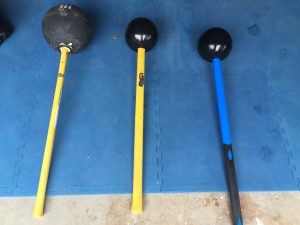You think you’ve come up with the next best fitness equipment sensation. Where do you even start to make your fitness product come to life? Having successfully (relatively so, perhaps!) gone through the process myself in the creation of two fitness products, I will walk you through the steps to make your pipe dream a reality.
Understanding Patents
On June 19, 2018 the United States Patent and Trademark Office issued patent #10,000,000. The current numbering system was put into use in 1836 so this doesn’t even account for the patents from 1790-1835. IBM itself has 9,262 patents. Still, the average American consumer has no idea how a patent works, what it does, or how to get one.
Furthermore, most of us don’t know where most of the things we use come from or how they’re made. That extends to our dumbbells, resistance tubes, slidey-ma-jigs, and stretchy-ma-bobs. How does one make a thing, and how do you get it patented (and is it even worth it)?
Although I am not a patent attorney or Steve Jobs, I have some experience with the process. I own a small line of functional training tools called MostFit. We have two patented pieces of equipment called the Core Hammer and the SYN Rings. The Core Hammer is a great example of this creative process. Ask me if it’s worth it to pursue an idea or invention?
The answer is simple: definitely yes! And also, possibly absolutely no!
Inventing something useful, clever, and viable in the market is incredibly fulfilling. But actually creating it, marketing and selling it, or even licensing and getting distribution can be all-consuming and wallet-draining. Let me give you an idea of what it takes to turn an idea into reality.
The Creative Process
First, you create the world’s greatest fitness product in your head. Next, you realize it’s a terrible idea. That happens about 50 more times. Then, you come up with a truly good idea. A few trips to Home Depot, borrow a drill from your neighbor, use some kind of glue, and voila! You have yourself the first prototype of your new product.
I had a thought one day— “Why we don’t have a sledgehammer that we can just hit on the floor?” Seems like a great solution for our gyms, boot camps, team workouts, and the like.

The very first model was a blank hammer handle I bought from the store. I drilled a hole down the center lengthwise, then glued in a long threaded piece of metal. From there I drilled a hole on either end of a rubber medicine ball, placed the threaded rod through it, and finished with a large washer and a nut to hold it on. That med ball cracked in half in about 1 minute.
But I had the start to a road map for the next, better prototype.
I spent time studying materials, trying various ideas in the garage and testing products myself and with clients. I examined existing products and used samples, in this case, to find my ideal material. I researched a number of fitness products that seemed like what I wanted to make, started conversations at tradeshows, and asked questions of other people in the industry—and found out about urethane. After trying a few manufacturers we finally had a working prototype. Mind you, this process can eat up a number of hours per week, and thousands of dollars. But, the joy of holding in your hand something you created is without comparison.
Things were looking good. One doesn’t have to become an expert in every step of the process or with every material, but being a garage inventor takes a serious vested interest. Some large companies employ full-time materials scientists and product development teams. There are a number of companies and specialists that can assist you on the journey. Many are small local businesses themselves, who can help source ideas, materials, and even prototypes.
I work with a company in Los Angeles called Hexcorp. They have a few employees here and in China. There are also what’s called a Maker-Space–an ever-more popular facility where artists and inventors have memberships and access to a number of 3-D printers, CNC machines, and other design equipment.
Manufacturing and Sales of Your Fitness Product
Where do you begin when it comes to producing your prototype? Where do things even come from?
Economist Leonard E. Read wrote in his famous 1958 essay ‘I, Pencil”:
“I am a lead pencil—the ordinary wooden pencil familiar to all boys and girls and adults who can read and write. You may wonder why I should write a genealogy. Well, to begin with, my story is interesting. And, next, I am a mystery—more so than a tree or a sunset or even a flash of lightning. But, sadly, I am taken for granted by those who use me, as if I were a mere incident and without background.”
Read intended in his essay, which was written as a first-person account told by an actual pencil, to convey how deep and complicated the economy and supply chain can be. Even something as simple as a number #2 pencil is far too complicated for most to understand or control.
For instance, I might understand how to cut down a tree to supply the wood, but I don’t know how to make the axe. Nor do I know how to make the truck that transports the wood. Then there are the machines at the mill. And that’s just a fraction of the components of a pencil. Forget about the yellow paint, the eraser, and the metal eraser holder thing (that’s called a Ferrule by the way).
Here is where we have to take the greatest risk as inventors and entrepreneurs. How much time and money can we risk before we even know if a product is viable? Thankfully companies like Hexcorp can help quote production quantities and costs for a reasonable fee. Usually when mass producing items a manufacturer will have a minimum quantity order (MOQ), and their price will be higher the lower that quantity is. Now you can compare the costs with the demand in the market, and how much you think people will pay.
When I decided to release the Core Hammer I had to try my best to balance the cost per unit, with what people were already paying for fitness sledgehammers, and what I thought the value of convenience would be. I’ll admit…this is still tough.
The last part of this process is to decide what business model you want to work with? Will you try to brand, market, and sell the product yourself through your own business entity? You can try to license it to other fitness equipment distributors like Power Systems or Aktiv Solutions. Or you can even try to sell your product (here’s where patents come in to play). Keep in mind the risk and reward can vary greatly depending on which option you choose.
Protecting Your Intellectual Property
If you haven’t yet been able to figure out what the “suits” are talking about when they say IP, it stands for Intellectual Property. In other words, IP encompasses a patented process, product, or utility or a trademark or copyrighted material. Obtaining a patent can be a difficult, costly process, and its value is not always obvious.
Patent search fees can be anywhere from $1,000-$3000, writing and filing fees for lawyers can easily be $5,000- $16,000, and the actual Patent Office filing fees vary but are only a few hundred dollars. Securing a patent for your new fitness product is often more a matter of how you describe the product in your application and less of what the product actually is.
As a matter of fact, the invention doesn’t even need to actually exist, just the concept. Recall that I patented a sledgehammer. How hard do you think it was to describe a sledgehammer in a different way from the infinite number of hammers that exist? It was difficult but I managed to get a patent!
That doesn’t mean that someone else can’t make a hammer where the widget leans left instead of right. All it means is, I have the right to take someone to court and sue over infringement. And maybe I can protect my product. But the cost of that type of litigation could easily be more than we make in a year from sales. The real value of a patent is quite often in the marketability of the invention toward the consumer, or as mentioned above, to a potential buyer or licensure.
It can provide a perception of legitimacy in a crowded market or a sense of value to a potential partner. Patent law continues to change in the US and abroad and will undoubtedly see more change in the future.
Is Creating Your Fitness Product Really Worth It?
All kidding aside, it’s difficult to advise whether someone should pursue an invention or not. There were days during the busiest years for my products where I would wake up and hope that no one wanted any orders for a month so I would have an excuse to close down. And there are other days where I brainstormed 100 bad ideas in a day and couldn’t wait to try again the next morning.
The value of creativity and invention goes far beyond any monetary return on investment. Pursuing the production of a fitness invention is a creative and artistic endeavor. It can provide a sense of pride and accomplishment, if not a large source of income. Even creating that initial garage prototype can be an uplifting experience. I wouldn’t trade a single bounced check or 20 hour day for all of the great colleagues I connected with and opportunities that my simple inventions have allowed me—of that I am certain.
 About the author: Andrew is a recognized speaker in the fitness industry, master trainer, and serves as Director of Education for AktivSolutions. He is a NASM and NFPT Certified Personal Trainer, creator of the MostFit line of fitness equipment, and has developed comprehensive fitness and wellness initiatives for health club & workplace wellness programs. Andrew’s passion centers around user engagement and human behavior. Checkout his website and follow him on Instagram.
About the author: Andrew is a recognized speaker in the fitness industry, master trainer, and serves as Director of Education for AktivSolutions. He is a NASM and NFPT Certified Personal Trainer, creator of the MostFit line of fitness equipment, and has developed comprehensive fitness and wellness initiatives for health club & workplace wellness programs. Andrew’s passion centers around user engagement and human behavior. Checkout his website and follow him on Instagram.
Guest authors offer experience and educational insights based on their specific area of expertise. These authors are contributing writers for the NFPT blog because they have valuable information to share with NFPT-CPTs and the fitness community at-large. If you are interested in contributing to the NFPT blog as a guest, please send us a note expressing your interest and tell us how you can contribute valuable insights to our readers. We look forward to hearing from you! Send to editor@nfpt.com

